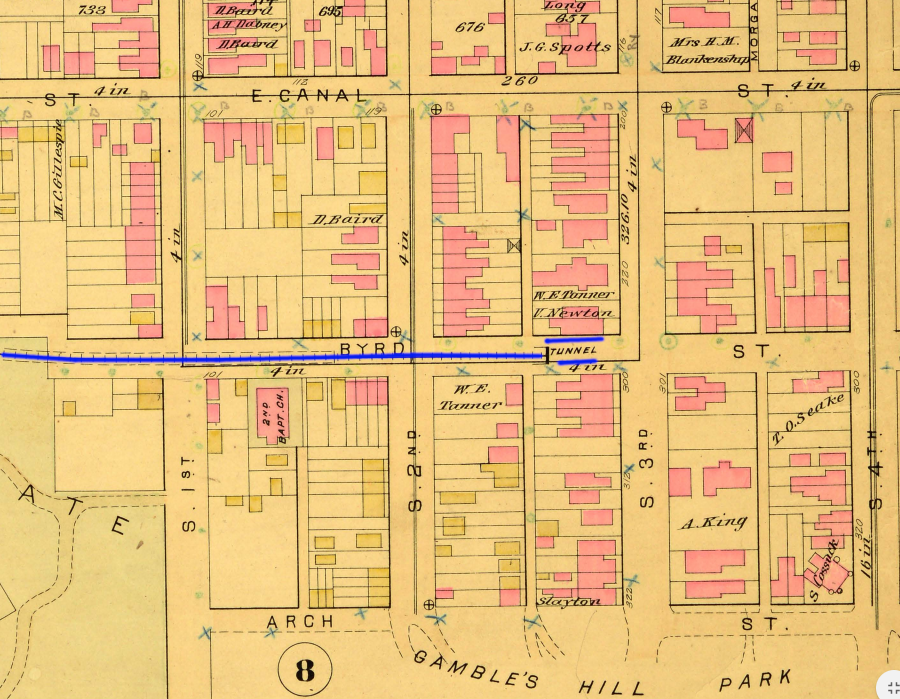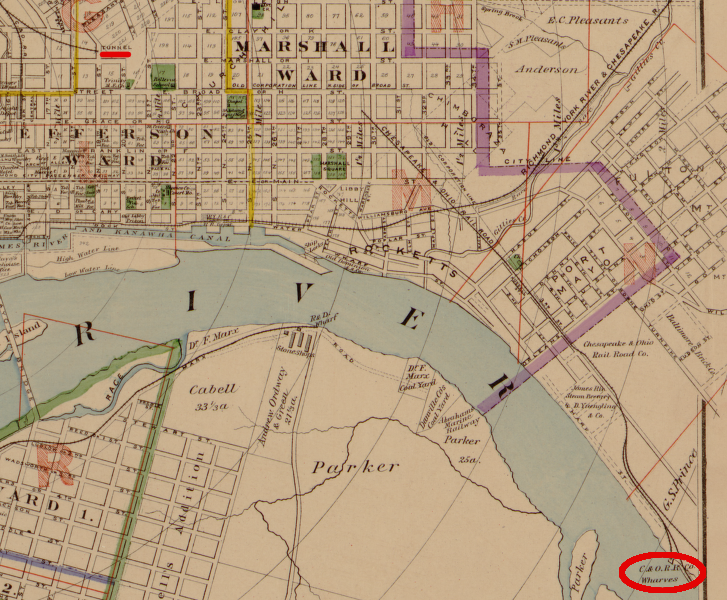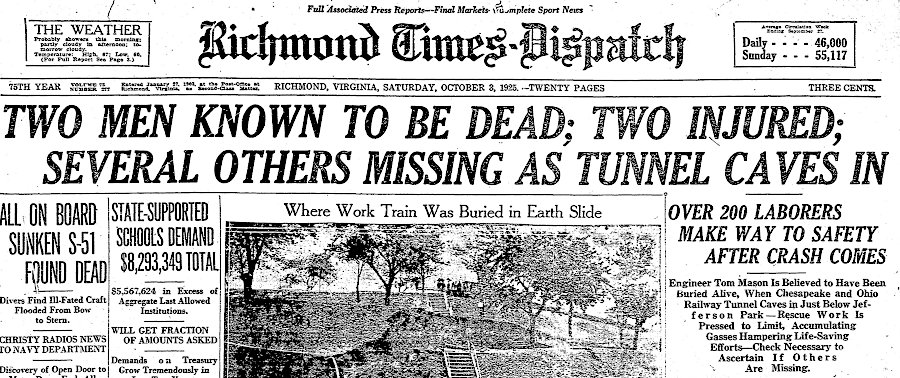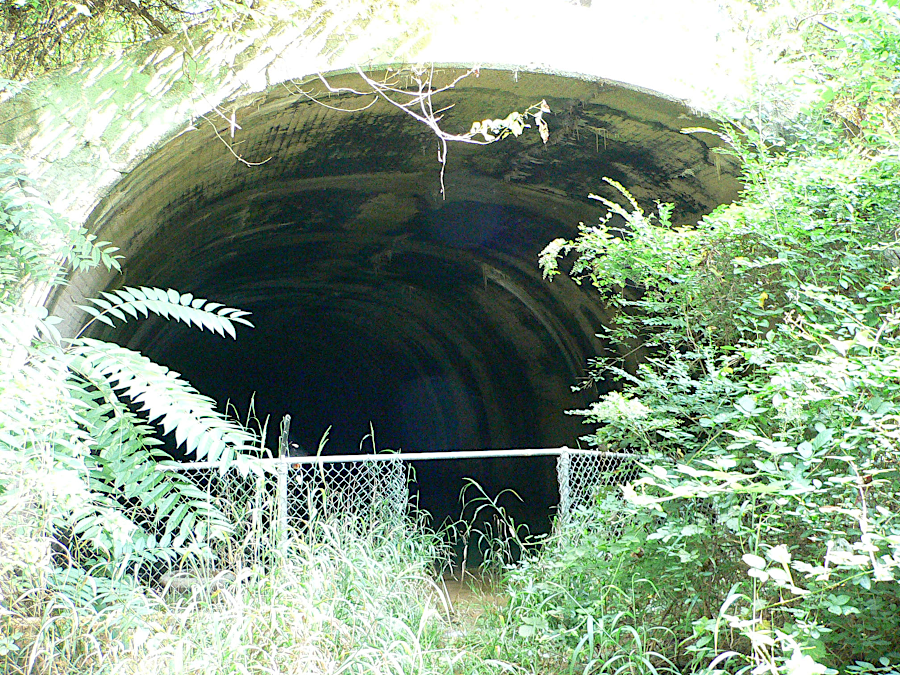
in 1873, the Chesapeake and Ohio Railway completed a tunnel through Church Hill in Richmond
Source: Virginia Commonwealth University, Church Hill Tunnel (photo by Harris H. Stilson)

in 1873, the Chesapeake and Ohio Railway completed a tunnel through Church Hill in Richmond
Source: Virginia Commonwealth University, Church Hill Tunnel (photo by Harris H. Stilson)
The first railroad tunnel in Richmond was two blocks long. The Richmond, Fredericksburg and Potomac and Richmond and Petersburg Connection Railroad ("Connection Railroad") was constructed in 1867 as the city recovered from the Civil War.
The short stretch linked the two railroads directly for the first time. It ran from the Richmond and Petersburg Railroad station on Byrd Street, next to the James River and Kanawha Canal, to the Richmond, Fredericksburg and Potomac (RF&P) depot near Broad Street. To minimize the steepness of the slope up Gambles Hill to Belvidere Street and then north to the new "Elba" junction on Broad Street, a railroad tunnel was carved on Byrd Street underneath 3rd and 4th streets. Today that stretch is occupied by the Downtown Expressway.1

the first railroad tunnel in Richmond, for the Connection Railroad, was dug in 1867 underneath 3rd and 4th Street
Source: Virginia Comonwealth University, Baist Atlas of Richmond - Outline & index map Richmond and vicinity (1899)
The Chesapeake and Ohio (C&O) Railroad cut the second railroad tunnel, the 3,927-foot long Church Hill Tunnel, in 1871-1873. Church Hill had been named for St. John's Church, where Patrick Henry had delivered his stirring "Give me liberty or give me death" speech at the Second Virginia Convention in 1775.
The tunnel provided access from the old Virginia Central station in Shockoe Valley to the railroad's new docks on the James River, built at the site of what became Intermediate Terminal.

before construction of the Church Hill Tunnel and new railroad docks, the Chesapeake and Ohio Railroad tracks ended just south of Grace Street in Shockoe Valley
Source: Virginia Commonwealth University, Baist Atlas of Richmond, VA (1889)
The Church Hill tunnel, running from 19th and East Marshall Street to 31st and East Grace Street, provided a direct connection to the river. A decade later in 1882, the Chesapeake and Ohio Railroad extended its line 74 miles east to a deeper water terminal at Newport News.


the Church Hill Tunnel was constructed to provide a faster route to the railroad's docks near Rocketts Landing
Source: Library of Congress, Illustrated atlas of the city of Richmond, Va (Frederick W. Beers, 1877); Virginia Commonwealth University, Baist Atlas of Richmond, VA (1889)
The clay soil in Church Hill created an engineering challenge. During tunnel construction, the sedimentary formations subsided. That caused the home of the St. John's Church minister to collapse and broke nearby gas lines. One major sinking event swallowed several houses:2
In 1901 the railroad completed a viaduct along the James River to bypass the congested route through the city. That viaduct created a unique three-level crossing of tracks that became famous. The new viaduct provided the needed access to the Intermediate Terminal and the shipping terminal at Newport News. The Church Hill Tunnel was closed, except for intermittent use in 1902.
In 1913, the east end of the tunnel was extended 241 feet to permit Richmond to build a new section of Grace Street. A 1915 assessment by the Chesapeake and Ohio Railroad revealed the tunnel needed to be reinforced. The timbers added to support the roof blocked the passage of trains.
In 1925, the railroad began to re-open the tunnel in order to accommodate the demand to move more trains through Richmond to Newport News. Ditches were excavated beneath the existing brick walls, apparently as part of an effort to widen the tunnel in order to accommodate larger freight cars.
As part of the re-opening, workers began to install concrete arches to support the roof and walls. That involved digging into the clay sediments at the sides of the tunnel.
The weakened walls, without adequate bracing, could not continue to support the 70 feet of dirt on top of the tunnel. Shortly after 3:00pm on October 2, 1925, a few bricks fell out of the ceiling and the electric lights in the tunnel flashed, then almost 200 feet of the roof on the western end of the tunnel collapsed. Fissures as deep as 30 feet developed in the ground above the collapsed portion. Because the fissures developed in Jefferson Park rather than in the developed portion of Church Hill, no houses were destroyed.

western portal of the Church Hill Tunnel after it collapsed
Source: Virginia Museum of History and Culture, On This Day (October 2, 2025)
At the time of the cave-in, almost 200 men were working in the tunnel. Some were warned by the bricks and flickering lights on the western end, while others felt the rush of air as the falling roof compressed the volume of the tunnel. All who escaped reached safety by racing in the dark to the eastern portal:3
A work train with one locomotive and 10 flatcars was buried in the cave-in. The engineer in the locomotive was killed, along with potentially several more. The fireman in the locomotive was scalded when steam was released as the locomotive's boiler was crushed and died that night. The conductor and one brakeman on the train crew were injured; a second brakeman was briefly hospitalized for shock.
The attention paid to the many more workers in the tunnel, mostly black laborers, was not as detailed. The Richmond Times-Dispatch reported on October 3:4

western portal of the Church Hill Tunnel after it collapsed
Source: Richmond Times-Dispatch, Two Men Known To Be Dead; Two Injured; Several Others Missing As Tunnel Caves In (October 3, 1925)
The engineer's body was recovered after nine days of digging through three shafts from the surface, but the bodies of two laborers remain buried with the train. Efforts to recover them were abandoned as the clay roof continued to collapse. The railroad added support to the portion of the tunnel that had not collapsed by installing cribs of railroad ties, then filled the tunnel with sand. Each end was sealed with a concrete plug, creating a tomb.


a concrete wall was built about 100 yards inside the eastern entrance to the Church Hill Tunnel
Source: Jkmscott, Church Hill Tunnel
Subsidence is still occurring. In 1962, a house above the tunnel collapsed and a workman died.
The sand has settled, the wooden cribbing installed after the collapse has rotted, and the water that steadily leaks through the roof has almost filled the tunnel. Since the 1925 collapse, more structures on top of the hill have shifted.
There was an attempt to recover the buried train in 2006. Efforts stopped when engineers feared that pumping water out of the tunnel would cause the sediments to collapse again. The concrete portals at the eastern and western ends keep millions of gallons of water trapped inside, along with the train and bodies.5
Source: Connor Exploring, Haunted Church Hill Tunnel: Deadly Tragedy of 1925 (Raft Exploration)

the Church Hill Tunnel was completed in 1873, closed in 1901, and collapsed in 1925
Source: Virginia Commonwealth University, Atlas of the City of Richmond (George William Baist, 1889)
Source: Virginia Public Media, Church Hill Train Tunnel Collapse | Hidden History with Brian Bullock

eastern portal of the Church Hill Tunnel under construction in 1873
Source: Virginia Museum of History and Culture, On This Day (October 2, 2025)